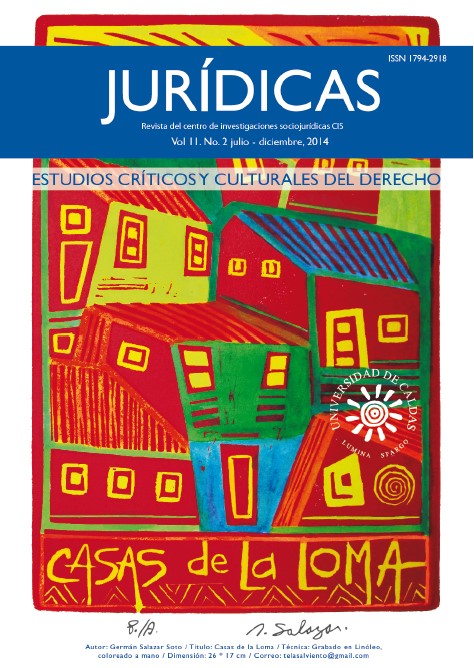Authors
Abstract
The objective of this article is to identify possible challenges the Pacific Alliance will have to face in terms of economic competition policy. To this end, the case of the competition policy model of the European Union, which consolidates a single market within a Regional Trade Agreement analyzed from the regional integration theory, is taken. Among the conclusions in the article it is important ot highlight that the Pacific Alliance is not only a trade integration efffort, but also addresses social and political objectives. However, the Pacific Alliance is still in its initial stages in terms of its institutional structure and greater progress is expected for it to be able to face the diverse problems of regionalism, as well as in the competition area. Member countries will need to adjust their sociopolitical and legal regulations and stipulations taking into account the current developmental stage of their economies.
References
Amat, Y. (2014). Canciller explica el alcance del acuerdo comercial de Alianza del Pacífico. Recuperado de http://www.eltiempo.com/archivo/documento/CMS-13473735.
Bache, I., Stephen G. and Bulmer, S. (2006). Politics in the European Union. Oxford, England: Oxford University Press.
Bakhoum, M. (2012). Introduction. En J. Drexl, M. Bakhoum, E. Fox, M. Gal and D. Gerber (Comps.), Competition policy and regional integration in developing countries. London, England: Edward Elgar publishing.
Baldwin, R. and Thornton, P. (2010). Multilateralising regionalism: Ideas for a WTO action plan on regionalism. Genève, Switzerland: Graduate Institute of International and Development Studies.
Bilal, S. and Olarreaga, M. (1998). Regionalism, competition policy and abuse of dominant position. European Institute of Public Administration Working Paper, 98 (01), 1-22.
Botta, M. (2011). The role of competition policy in the Latin American regional integration: A comparative analysis of CARICOM, Andean Community and MERCOSUR. IX Annual Conference of the Euro-Latin Study Network on Integration and Trade, Appenzel, Switzerland.
Caporaso, J. (1998). Regional integration theory: Understanding our past and anticipating our future. En W.Sandholtz and A. Stone (Comps.), European integration and supranational governance. Oxford, England: Oxford University Press.
Christiansen, T., Jørgensen, K.E. and Wiener, A. (2001). The social construction of Europe. London, England: SAGE.
Craig, P. and de Búrca, G. (2003). EU Law: Text, cases and materials. Oxford, London: Oxford University Press.
Ferrer, A. (2006). Hechos y ficciones de la globalización. Argentina y el MERCOSUR en el sistema internacional. Buenos Aires, Argentina: Fondo de Cultura Económica.
Fox, E.M. (2012). Competition, development and regional integration: In search of a competition law fit for developing countries. NYU Law and Economics Research Paper Series, 11 (04), 1-24.
Gamble, A. and Payne, A. (1996). Introduction: The political economy of regionalism and world order. Regionalism and world order. Basingstoke, England: Macmillan Press.
García, P. (2013). Acotación a la Alianza del Pacífico. Recuperado de
http://blog.uexternado.edu.co/acotacion-a-la-alianza-del-pacifico/
Gardini, G.L. (2013). The added value of the Pacific Alliance and ‘modular regionalism’ in Latin America. Recuperado de
http://blogs.lse.ac.uk/ideas/2013/06/the-added-value-of-the-pacificalliance-and-modular-regionalism-in-latin-america/.
George, S. (1996). The European Union, 1992 and the fear of ‘Fortress Europe’. En A. Gamble and T. Payne (Comps.), Regionalism and world order. Basingstoke, England: Macmillan Press.
Haas, E.B. (1958). The uniting of Europe: Political, social and economic forces. Stanford, USA: Stanford University Press.
Haas, E.B. (1964). Beyond the Nation-state: Functionalism and international organization. Stanford, USA: Stanford University Press.
Haas, E.B. (1970). The study of regional integration: Reflections on the joy and anguish of pretheorizing. International Organization, 24 (4), 607-646.
Hettne, B. (2006). Beyond the ‘new’ regionalism. En A. Payne (Comp.), Key debates in new political economy. Abingdon, England: Routledge.
Hix, S. (2005). The political System of the European Union. Basingstoke, England: Palgrave Macmillan.
Hoffmann, S. (1966). Obstinate or obsolete? The Fate of the nation-state and the case of Western Europe. Daedalus, 3, 862-915.
Hveem, H. (2006). Explaining the regional phenomenon in an era of globalization. R. Stubbs and G. Underhill (Comps.), Political economy and the changing global order. Oxford, England: Oxford University Press.
Hurrell, A. (1995). Regionalism in theoretical perspective. En L. Fawcett and A. Hurrell (Comps.), Regionalism in world politics. Oxford, England: Oxford University Press.
Ibarra Pardo, G. (1993). Políticas de competencia en la integración en América Latina. Integración Latinoamericana, 45-51.
Lindberg, L. (1963). The Political Dynamics of European Economic Integration. Stanford, USA: Stanford University Press.
Lowenfeld, A. (2008). International economic law. Oxford, USA: Oxford University Press.
Malamud, A. (2003). Presidentialism and Mercosur: A hidden cause for a successful experience. En F. Laursen (Comp.), Comparative regional integration: Theoretical perspectives. London, England: Ashgate.
Martin, S. (2001a). Competition policy. En M. Artis and F. Nixson (Comps.), The economics of the European Union: Policy and analysis. Oxford, England: Oxford University Press.
Martin, S. (2001b). Industrial organization: a European perspective. Oxford, England: Oxford University Press.
Mejía López, R. (2014). Alianza Pacífico: mal negocio para el agro colombiano. Recuperado de http://www.portafolio.co/opinion/alianza-pacifico-mal-negocio-el-agro-colombiano.
Mols, M. (1993). Regionalismus und Kooperation in Lateinamerika und Suedostasien. Ein politikwissenschaftlicher Vergleich. Berlin, Germany: LIT Verlag.
Monti, G. (2002). Article 81 EC and public policy. Common Market Law Review, 39 (5), 1057-1099.
Moravcsik, A. (1998). The choice for Europe, Social Purpose and State power from Messina to Maastricht. Ithaca, USA: Cornell University Press.
Moravcsik, A. (1993). Preferences and power in the European Community: a liberal intergovernmentalist approach. Journal of Common Market Studies, 31 (4), 473-524.
Motta, M. (2004). Competition policy: Theory and practice. Cambridge, England: Cambridge University Press.
Nolte, D. and Wehner, L. (2013). The Pacific Alliance casts its cloud over Latin America. GIGA Focus, 8, 1-8.
Pelkmans, J. (2001). European integration: Methods and economic analysis. Harlow, England: Pearson.
Ramírez, S. (2013). Regionalism: The Pacific Alliance. Recuperado de
http://www.americasquarterly. org/content/regionalism-pacific-alliance
Rittberger, B. and Schimmelfennig, F. (2005). Integrationstheorien: Entstehung und Entwicklung der EU. En K. Holzinger et al. (Comps.), Die Europaeische Union: Theorien und Analysekonzepte. Paderborn, Germany: Schoeningh.
Sandholtz, W. and Stone Sweet, A. (1998). European integration and supranational governance. Oxford, England: Oxford University Press.
Sandholtz, W. and Zysman, J. (1989). 1992: Recasting the European bargain. World Politics, 42 (1), 95-128.
Sauter, W. and Langer J. (2007). Competition policy. En A. El-Agraa (Comp.), The European Union: Economics and policies. Cambridge, USA: Cambridge University Press.
Schiff, M. and Winters, L. A. (2003). Regional integration and development. Oxford, England: Oxford University Press.
Schmitter, P. (1969). Three neo-functional hypotheses about international integration. International Organization, 1 (23), 161-166.
Schneider, B.R. (2004). Business politics and the state in twentieth-century Latin America. Cambridge, USA: Cambridge University Press.
Soderbaum, F. (2003). Introduction. En F. Soderbaum and T. Shaw (Comps.), Theories of new regionalism. Basingstoke, England: Palgrave Macmillan.
Spindler, M. (2002). New regionalism and the construction of global order. CSGR Working Paper, 93 (2), 1-31.
Spindler, M. (2005). Regionalismus im Wandel: Die neue Logik der Region in einer globalen Oekonomie. Wiesbaden, Germany: VS Verlag.
Tsoukalis, L. (1997). The new European economy revisited. Oxford, England: Oxford University Press.
Tvevad, J. (2014). The Pacific Alliance: Regional integration or fragmentation? Policy Department, Directorate-General for External Policies. Recuperado de
http://www.europarl.europa.eu/RegData/etudes/briefing_note/join/2014/522318/EXPO-FET_SP(2014)522318_EN.pdf
Uruena, R. (2006). The World Trade Organization and its powers to adopt a competition policy. International Organizations Law Review, 3, 55-91.
Venables, A. and Winters, L.A. (2004). Economic integration in the Americas: European perspectives. En A. Estevadeordal, D. Rodrik, A. Taylor and A. Velasco (Comps.), Integrating the Americas: FTAA and beyond. Cambridge, USA: Harvard University Press.
Wallace, W. (1990). Introduction. The dynamics of European integration. London, England: Pinter for the Royal Institute of International Affairs.
Wallace H. and Wallace, W. (2000). Policy-making in the European Union. Oxford, England: Oxford University Press.
Winters, L.A. (1997). What can European experience teach developing countries about integration. The World Economy, 20 (7), 889-912.
Wunderlich, J.U. (2013). Regionalism, globalization and international order. Europe and Southeast Asia. London, England: Ashgate.

 PDF (Español)
PDF (Español)
 FLIP
FLIP





















